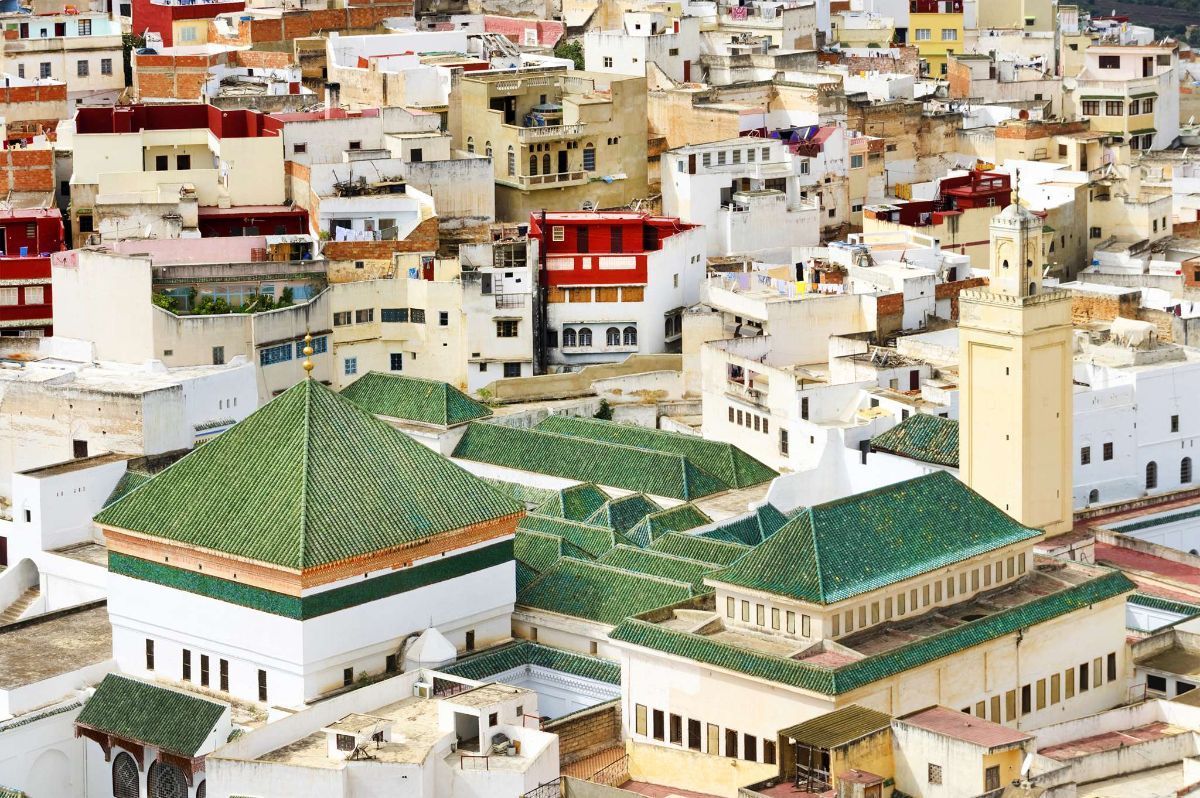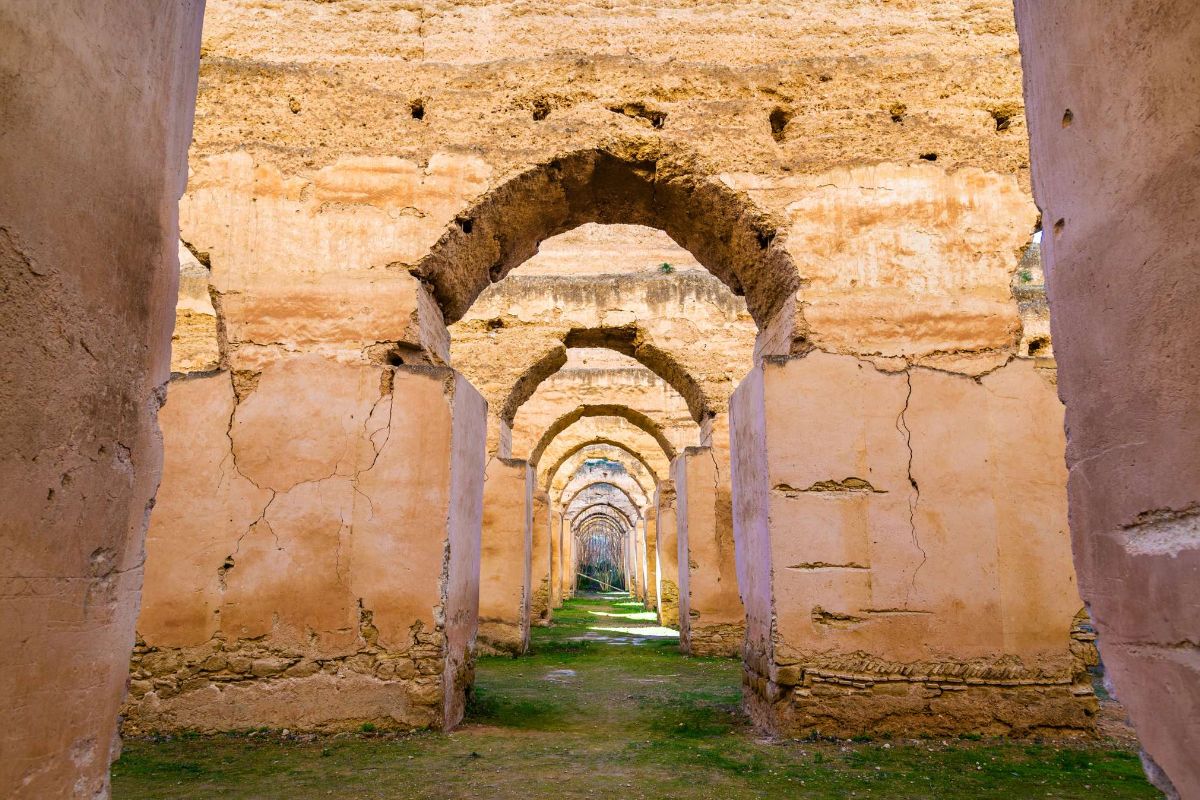Meknes, also called Meknes in some languages, is a relatively small city, but has much to offer the visitor in terms of monuments and tourist attractions. It preserves one of the most genuine historical medinas in the country, with buildings that bear witness to its splendid past. But at the same time, the atmosphere that the traveler will find here has nothing to do with mass tourism (although more and more people are encouraged to discover its beauty): popular life continues its course, even in the medina, with traditional elements ranging from handicrafts to local cuisine.
Meknes is a city in the interior of Morocco that is administratively part of the Fez-Mequinez region. It is located more or less halfway between Rabat and Fez, and in the middle of the A2 highway that connects both cities. The environment, in fact, is very similar to that of the latter, with cultivated fields of fruit trees, argan trees and cereal plantations.
This is a list of distances to give you an idea of how close or far they are from other destinations:
Given its proximity to Fez, the best way to travel here from other countries is through its airport: Fez-Saiss, where flights arrive from many European countries, such as the United Kingdom, Germany, Spain and France.
For domestic travel, the bus is a collective solution widely used by Moroccans themselves, but not so much by tourists looking for comfort and speed. The train offers a higher quality standard, but its agility and frequency are not the most suitable for large tourist circuits. Therefore, private road transport is the ideal option for those traveling to Meknes from other nearby cities.

Meknes is inextricably linked to Sultan Mulay Ismail, from the late seventeenth and early eighteenth centuries. But before that time, Meknes already existed as such, although with a much more humble and reduced dimension. The name of the city derives from its founders: the Meknassa tribe, who settled here after the fall of the Roman Empire, which dominated this territory as part of the great province of Mauritania Tingitana.
The successive dynasties reigning in what is now Morocco made their contributions later: the Almoravids built a small kasbah, the Almohads carried out an urban reform that did not take hold and the Marinids erected a palace (majzen) in the old kasbah. But in the 16th century, during the decline of the Marinids, the rule of the Wattasids and the arrival of the Saadids, the city lived between instability and decadence, like the rest of the region.
The accession to the throne of the second Alaouite, Mulay Ismail, in 1672 meant a radical change for Meknes: this sultan, one of the most powerful in the history of Morocco, chose it as his capital, trying to distance himself from Fez and Marrakech, previous capitals and less secure places for the newly arrived dynasty. Therefore, he built a city to his own specifications, even if he had to demolish a large part of what had been standing until then. In fact, he was a sultan who has also gone down in history for his authoritarian and ruthless nature, ruling with an iron fist.
What remains today of that period are great monuments to visit, which in some cases were completed during the reign of his successors. However, after the death of Mulay Ismail, the capital returned to Fez, plunging Meknes into another long period of decline that lasted until the 20th century.
However, some of the monuments of that period remain intact, which led to the declaration of its historic city as a World Heritage Site. And that has also aroused the interest of many travelers, who set out to discover this destination with a burst of romanticism and an exploratory impulse.

Meknes is not always part of the major tourist routes in Morocco. In some cases, because travelers are unaware of its beauty or do not find enough reasons to add it to their roadmap. But here are some reasons that will encourage you to do so:
The places of interest in Meknes are mainly divided between two large areas: the historic medina and what is known as the imperial city, that is, the great complex in which the Royal Palace of Mulay Ismail and the rest of official buildings were located.
The old medina of Menkes retains its original layout, as well as numerous buildings and vestiges that allow us to know how this small town was, even before it became the capital of the Alawite sultanate in the late seventeenth century. These are the most interesting monuments and spaces:

Although the term ‘imperial city’ is used for the entire city of Meknes, it is more appropriate to use it to refer to a vast area developed by Sultan Mulay Ismail as a center of power. These are the most outstanding places:
Meknes is perhaps not shown as one of the most prominent cities for the premium tourism sector. In fact, as we have mentioned above, one of its attractions is its economic character, compared to other tourist destinations in the country. However, this does not mean that there are no establishments and service providers of real quality. Therefore, those who wish to enjoy the highest quality during their stay in this city will be able to do so in places such as the following:
However, Chic Morocco makes it easier for you: our agency is an expert in high-end travel and we have a portfolio of suppliers that will offer you the highest quality standards. Just contact us for more information, either in the city of Meknes or in other cities that are part of your roadmap. We will be happy to help you and design your tailor-made program.







